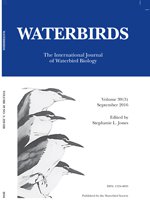Breeding King Rails (Rallus elegans) have become more reliant on coastal marshes, but these are prone to variation in water level influenced by estuarine effluent and storm surge. Nest-building behavior in King Rails was studied in a natural coastal marsh subjected to a wind-driven tide system, where rapid water level rise from storm surge has led to nest inundation. To determine whether breeders exhibited plasticity in nest building in response to water level variation, nest height and water level were monitored at 2- to 3-day intervals, and video was used to quantify building behavior. Average height varied substantially among King Rail nests, indicating plasticity in overall building effort. King Rails constructed significantly taller nests at sites with greater variation in water level. Parents spent a greater proportion of time nest building when the water level was closer to the nest rim. The majority of nest accumulation occurred before laying ceased. Though King Rails continue to build through the nesting cycle, which is likely to counteract settling and improve the structural integrity of nests, they may not be able to increase nest height quickly enough to avoid flooding when faced with rapidly rising water.
How to translate text using browser tools
1 September 2016
King Rails (Rallus elegans) Vary Building Effort and Nest Height in Relation to Water Level
Amanda J. Clauser,
Susan B. McRae
ACCESS THE FULL ARTICLE

Waterbirds
Vol. 39 • No. 3
September 2016
Vol. 39 • No. 3
September 2016
flooding
King Rail
nest building
Plasticity
Rallus elegans
wind-driven tide




